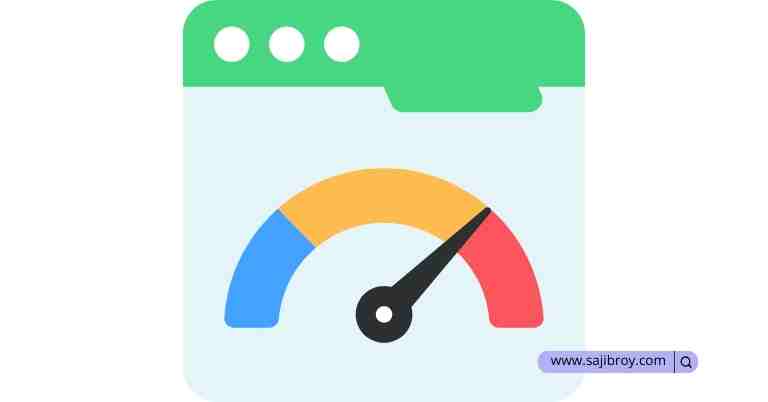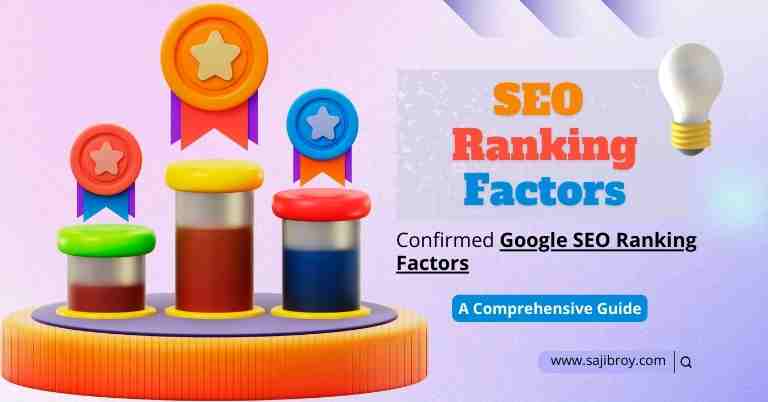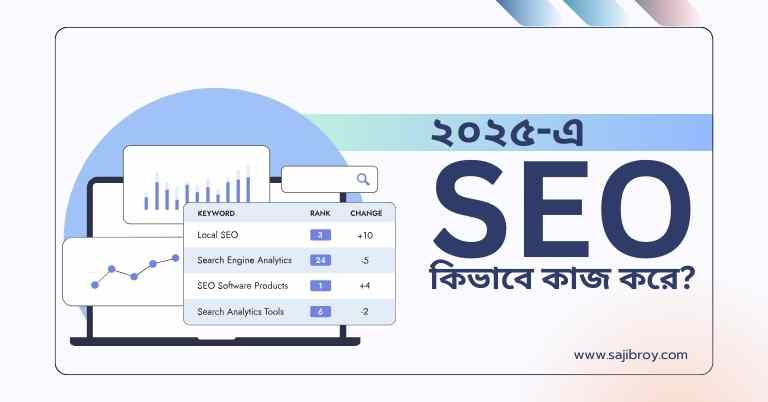In today’s digital age, having a strong online presence is crucial for businesses of all sizes. Search engine optimization (SEO) plays a vital role in driving traffic to your website, and Google is the most popular search engine in the world. But how does Google decide which websites to display at the top of the search results? The answer lies in Google SEO ranking factors, a complex set of algorithms that analyze various factors to determine the relevance and authority of a website. In this blog post, I’ll explore some of the most important Google SEO ranking factors that you need to know to improve your website’s search engine rankings and drive more traffic to your site.
SEO aims to optimize a website’s content and structure to make it easier for search engines to crawl, index, and rank it in response to search queries. In this way, SEO helps businesses attract more organic traffic to their websites and increase their online presence. Understanding how search engines work is essential to creating an effective SEO strategy.
For example, let’s say you run a bakery in New York City and want to attract more customers to your website. A potential customer searches for “best cupcakes in NYC” on Google. Google’s algorithm crawls the web and retrieves relevant content that matches the search query. The algorithm then ranks these results based on various ranking factors to provide the user with the most relevant results.
Let's See the Topic Overview
Top 16 Google SEO Ranking Factors
Google, the world’s most popular search engine, uses a complex algorithm to rank websites based on various factors, including relevance, authority, and user experience. As a result, it’s crucial to understand and implement the most important Google SEO ranking factors to ensure your website appears at the top of search results pages. Let’s explore the most important Google SEO ranking factors
1. Keyword Research

Keyword research is a critical component of SEO and one of the most important Google SEO ranking factors. It involves identifying the words and phrases that people search for in relation to your business or topic and using that information to optimize your content for those specific keywords. By conducting thorough keyword research, you can identify high-traffic, low-competition keywords that can help your content rank higher in search engine results pages (SERPs).
Here’s an example of how to conduct keyword research:
Let’s say you run a pet grooming business in New York City. You want to create a blog post about the benefits of professional pet grooming, but you’re not sure which keywords to target.
Here are the steps you can take to conduct keyword research:
- Brainstorm Ideas: Begin by brainstorming a list of potential keywords that you think people might search for in relation to pet grooming. Some examples might include “pet grooming services,” “dog grooming NYC,” “cat grooming near me,” and “professional pet grooming.”
- Use Keyword Research Tools: Next, use keywords research tools like Google Keyword Planner, Ahrefs, or SEMrush to identify additional keywords and analyze search volume and competition. These tools can give you insight into which keywords are most popular, which have low competition, and which have a high click-through rate (CTR).
- Analyze Your Competitors: Look at the keywords that your competitors are targeting and ranking for. This can give you insight into what’s working in your industry and help you identify gaps in your own keyword strategy.
- Consider Long-Tail Keywords: Long-tail keywords are longer, more specific phrases that people search for. While they may have a lower search volume, they also have lower competition and can be easier to rank for. For example, “best dog grooming services in NYC” is a long-tail keyword that may be easier to rank for than a more general keyword like “pet grooming.”
- Group and Organize Keywords: Once you have a list of potential keywords, group them by theme and organize them by search volume and competition. This will help you prioritize which keywords to target in your content and which to save for future use.
By following these steps, you can conduct thorough keyword research and identify the best keywords to target in your content. Remember to focus on creating high-quality, informative content that provides value to your readers, and optimize your content with your target keywords to improve your rankings and attract more traffic to your website.
2. On-Page Optimization

On-page optimization is the process of optimizing the elements on a webpage to improve its visibility and relevance to search engines. On-page optimization involves optimizing the content, HTML source code, and other elements of a webpage to help search engines understand the topic of the page and rank it higher in search engine results pages (SERPs).
Here’s an example of how to optimize on-page elements:
Let’s say you’re optimizing a blog post about “10 Tips for Healthy Eating.”
Here are some of the on-page elements you can optimize:
- Title Tag: The title tag is the title of your webpage that appears in search engine results. Use a descriptive and attention-grabbing title that includes your target keyword. For example, “10 Tips for Healthy Eating: Boost Your Health and Energy.”
- Meta Description: The meta description is the brief summary that appears under the title tag in search engine results. Use a concise and compelling description that includes your target keyword and encourages users to click through to your webpage. For example, “Discover 10 easy tips for healthy eating that will help you boost your health and energy levels. Get started on your path to a healthier lifestyle today!”
- Headers: Use headers (H1, H2, H3, etc.) to break up your content into easy-to-read sections and include your target keyword in the H1 header. For example, “Tip #1: Start Your Day with a Nutritious Breakfast.”
- Content: Write high-quality, informative content that provides value to your readers and includes your target keyword and related keywords. Use bullet points, images, and videos to enhance the user experience and break up your content into digestible chunks.
- Images: Use relevant and high-quality images that are optimized for search engines. Use descriptive filenames and alt tags that include your target keyword. For example, “healthy-eating-tips.jpg” and “alt=’10 tips for healthy eating.'”
- URLs: Use short and descriptive URLs that include your target keyword. For example, “yoursite.com/healthy-eating-tips.”
By optimizing these on-page elements, you can improve the relevance and visibility of your webpage to search engines and increase your chances of ranking higher in SERPs. Remember to focus on creating high-quality, informative content that provides value to your readers and uses on-page optimization to help search engines understand the topic of your content.
3. Content Quality

Content quality is one of the most important Google SEO ranking factors nowadays. Creating high-quality, informative content that provides value to your readers and includes relevant keywords can help you rank higher in search engine results pages (SERPs) and attract more traffic to your website.
Here’s an example of how to create high-quality content:
Let’s say you’re creating a blog post about “10 Healthy Snack Ideas.”
Here are some tips to help you create high-quality content:
- Conduct Research: Conduct research on your topic to identify the most important and relevant information for your readers. Use reputable sources and provide accurate information that can be verified.
- Provide Value: Focus on providing value to your readers. Use your knowledge and expertise to provide insights and tips that your readers will find useful and actionable.
- Use Relevant Keywords: Use relevant keywords throughout your content to help search engines understand the topic of your content. Use keyword research to identify the most relevant and high-traffic keywords to target in your content.
- Organize Your Content: Organize your content into sections or subheadings to make it easy for your readers to follow. Use bullet points and numbered lists to break up your content into digestible chunks.
- Use Images and Videos: Use relevant images and videos to enhance the user experience and provide additional information. Use descriptive filenames and alt tags that include your target keyword.
- Edit and Proofread: Edit and proofread your content to ensure that it is free of errors and typos. Use tools like Grammarly or Hemingway Editor to check for grammar and style issues.
By creating high-quality, informative content that provides value to your readers and includes relevant keywords, you can improve the relevance and visibility of your content to search engines and attract more traffic to your website. Remember to focus on creating content that provides value to your readers and uses relevant keywords to help search engines understand the topic of your content.
4. Technical SEO

Technical SEO is an important aspect of any SEO strategy, as it focuses on improving the technical elements of your website to ensure it’s optimized for search engine crawlers. In 2024, technical SEO is a hot topic and the most essential Google SEO ranking factor.
Here’s an example of how to optimize your website for technical SEO:
- Improve Site Architecture: Your website’s architecture plays a crucial role in how search engines crawl and index your content. Ensure that your site has a clear and logical structure with easy-to-use navigation. This can improve the user experience and help search engines better understand the content on your website.
- Use Schema Markup: Schema markup is a structured data format that provides additional information to search engines about the content on your website. It can help search engines understand the context and relevance of your content, which can improve your rankings. For example, using schema markup for product pages can help search engines understand the price, availability, and reviews of the product.
- Optimize Crawlability: Crawlability refers to the ability of search engine bots to crawl and index your website. To optimize crawlability, ensure that your website has a robots.txt file that instructs search engines which pages to crawl and which to ignore. Additionally, you can use tools like Google Search Console to identify and fix crawl errors and ensure that your website is accessible to search engine bots.
- Improve Indexing: Indexing refers to the process of adding web pages to a search engine’s index. To improve indexing, ensure that your website has a sitemap that lists all the pages on your website. This can help search engines discover new pages and ensure that they are indexed quickly.
- Optimize Page Speed: Page speed is an important Google SEO ranking factor, and it’s important to ensure that your website loads quickly. This can be achieved by optimizing images, minifying CSS and JavaScript, and using a content delivery network (CDN).
By focusing on technical SEO, you can ensure that your website is optimized for search engine crawlers and improve your chances of ranking higher in search results. Keep in mind that technical SEO is an ongoing process, and it’s important to regularly monitor your website’s performance and make adjustments as needed.
5. Site Speed

Site speed is a crucial factor in SEO that can significantly impact your website’s rankings and user experience. Website loading speed is considered one of the top Google SEO ranking factors nowadays. A slow-loading website can lead to a poor user experience and discourage users from spending time on your site, which can negatively impact your bounce rate and overall SEO performance.
Here’s an example of how to improve your website’s load speed:
- Optimize Images: Large images can significantly slow down your website’s load speed. Optimize your images by compressing them without losing quality or using a tool like Smush. it.
- Use a Content Delivery Network (CDN): A content delivery network (CDN) is a network of servers that can help improve the load speed of your website by caching your content and delivering it to users from the server closest to them. This can help reduce latency and improve your website’s load speed.
- Use Browser Caching: Browser caching can help improve your website’s load speed by storing frequently used elements of your website in the user’s browser cache. This can help reduce the time it takes for your website to load and improve the user experience.
- Minimize HTTP Requests: Reduce the number of HTTP requests made by your website by minimizing the use of external scripts and stylesheets. This can help improve your website’s load speed and reduce the time it takes for users to access your content.
- Use a Fast Web Hosting Service: The quality of your web hosting service can significantly impact your website’s load speed. Choose a reliable web hosting service that provides fast and secure servers to help improve your website’s load speed.
By improving your website’s load speed, you can enhance the user experience and improve your website’s rankings in search engine results pages (SERPs). Remember to regularly monitor your website’s load speed using tools like Google PageSpeed Insights or GTmetrix and make necessary improvements to improve your website’s performance.
6. Mobile-Friendliness

Mobile-friendliness is an important Google SEO ranking factor, as more and more users are accessing the internet through their mobile devices. Optimizing your website for mobile devices can improve the user experience and help you rank higher in search engine results pages (SERPs).
Here’s an example of how to optimize your website for mobile devices:
- Use Responsive Design: Use responsive design to ensure that your website is optimized for mobile devices. Responsive design allows your website to adapt to different screen sizes and devices, providing a consistent user experience across all platforms.
- Optimize Navigation: Optimize your website’s navigation for mobile devices by using a simple and intuitive menu that is easy to navigate using a touchscreen. Use drop-down menus and hamburger menus to conserve space and make navigation more accessible.
- Use Mobile-Friendly Fonts: Use fonts that are easy to read on a small screen and avoid using small font sizes. Use a font size of at least 14 pixels to ensure that your content is legible on a mobile device.
- Optimize Images: Optimize your images for mobile devices by using smaller image sizes and optimizing your alt tags. Use descriptive filenames and alt tags that include your target keyword to help search engines understand the content of your images.
- Minimize Pop-ups and Interstitials: Minimize the use of pop-ups and interstitials on your mobile website. Pop-ups and interstitials can be frustrating for users and can negatively impact the user experience.
- Test Your Website on Mobile Devices: Test your website on different mobile devices to ensure that it is functioning properly and providing a good user experience. Use tools like Google’s Mobile-Friendly Test to check if your website is mobile-friendly.
By optimizing your website for mobile devices, you can improve the user experience and help you rank higher in search engine results pages (SERPs). Remember to regularly check your website’s mobile-friendliness and make necessary improvements to provide the best possible user experience for your mobile users.
7. Proper Internal Linking between Relevant Page
Proper internal linking between relevant pages is an important Google SEO ranking factor. Internal linking refers to linking to other pages within your own website. This helps search engines understand the structure of your website and how different pages are related to each other. It also helps to distribute authority and ranking power throughout your website.
One way to ensure proper internal linking is to use descriptive anchor text when linking to other pages. For example, if you’re writing a blog post about SEO, you might want to link to another page on your website that covers a related topic, like “5 Tips for Keyword Research.” Instead of using generic anchor text like “click here,” use descriptive anchor text like “Keyword Research Tips” to help search engines understand the context of the linked page.
Another way to improve your internal linking is to make sure your website has a clear and logical structure. Use categories and subcategories to group similar content together and create a clear hierarchy of pages. This not only helps search engines crawl and index your website, but it also helps visitors find what they’re looking for quickly and easily.
For example, let’s say you run a gardening website that covers a variety of topics, including vegetable gardening, flower gardening, and lawn care. You might create a top-level category for each of these topics and then create subcategories within each category. Within the vegetable gardening category, you might have subcategories for “Growing Tomatoes,” “Composting,” and “Container Gardening.” Within the “Growing Tomatoes” subcategory, you might have pages for “Tomato Varieties,” “Planting Tips,” and “Common Tomato Pests.” By linking between relevant pages within each subcategory and category, you can create a logical and easy-to-navigate website structure that both visitors and search engines will appreciate.
In summary, proper internal linking between relevant pages is an important SEO ranking factor that can help search engines understand the structure of your website and distribute ranking power throughout your site. By using descriptive anchor text and creating a clear and logical website structure, you can improve your internal linking and boost your search engine rankings.
8. Backlinks and Link Building

Backlinks are a critical factor in SEO that can significantly impact your website’s authority and rankings. Backlinks are links from other websites to your website and can signal to search engines that your website has valuable and authoritative content.
Here’s an example of how to build high-quality backlinks to improve your website’s authority and rankings:
- Create High-Quality Content: The first step in building high-quality backlinks is to create high-quality content that is informative, valuable, and shareable. Content that provides value to your audience is more likely to be shared by other websites, resulting in valuable backlinks.
- Guest Blogging: Guest blogging is an effective way to build high-quality backlinks to your website. Identify authoritative websites in your niche and offer to write a guest post for them. Ensure that the content you create is informative, relevant, and provides value to their audience.
- Broken Link Building: Broken link building is a technique that involves finding broken links on other websites and offering to replace them with a link to your content. Use a tool like Check My Links to identify broken links on other websites and offer to replace them with a link to your high-quality content.
- Use Social Media: Social media can be an effective way to build high-quality backlinks to your website. Share your content on social media platforms and encourage your followers to share your content with their audience. The more shares and likes your content receives, the more likely it is to be linked to by other websites.
- Use Infographics: Infographics are an effective way to create valuable and shareable content that can attract backlinks from other websites. Use a tool like Canva to create visually appealing infographics that provide value to your audience and are easy to share.
By building high-quality backlinks from authoritative websites, you can improve your website’s authority and rankings. Remember to regularly monitor your backlink profile and remove any low-quality or spammy backlinks that could negatively impact your website’s rankings.
9. User Engagement Metrics
User engagement metrics are important factors that can impact your website’s search engine rankings. These metrics include bounce rate, time on site, and click-through rate, which indicate how engaged and interested your website visitors are.
Here’s an example of how to focus on improving user engagement metrics to improve rankings and user experience:
- Improve Bounce Rate: The bounce rate is the percentage of visitors who leave your website after viewing only one page. A high bounce rate can negatively impact your website’s rankings. To improve bounce rate, ensure that your website provides a clear and relevant message and that your website’s navigation is user-friendly.
- Increase Time on Site: Time on site is the amount of time that visitors spend on your website. The longer visitors stay on your website, the more engaged they are with your content. To increase time on site, ensure that your website is easy to navigate, provides valuable and relevant content, and has a fast loading speed.
- Improve Click-Through Rate: Click-through rate (CTR) is the percentage of users who click on a link after viewing it. A high CTR indicates that your content is relevant and valuable to your audience. To improve CTR, ensure that your meta tags and headlines are clear, concise, and relevant to the content on your page. Use A/B testing to experiment with different headlines to find the most effective one.
- Use Interactive Content: Interactive content such as quizzes, surveys, and polls can help improve user engagement and time on site. Interactive content keeps visitors engaged and provides a personalized experience, which can improve user engagement metrics.
- Analyze User Behavior: Analyze user behavior using tools like Google Analytics to identify areas of your website that could be improved. Use this information to make data-driven decisions and improve user engagement metrics.
By focusing on improving user engagement metrics, you can improve your website’s rankings and provide a better user experience for your audience. Remember to regularly monitor and analyze user engagement metrics to make data-driven decisions and continuously improve your website.
10. Local SEO

Local SEO is an essential strategy for businesses that serve customers in specific geographic areas. It involves optimizing your website and online presence to appear in search results for relevant local queries.
Here’s an example of how to optimize your website for local search results:
- Include Location on Your Website: Including your location on your website can help search engines understand where your business is located and what services you offer in that location. This can be done by including your address and phone number on your website’s footer or contact page.
- Create a Google My Business Profile: Google My Business (GMB) is a free tool that allows businesses to manage their online presence on Google. By creating and optimizing a GMB profile, you can increase your chances of appearing in local search results. Be sure to include accurate and up-to-date information such as your business name, address, phone number, and website URL.
- Get Listed in Local Directories: Getting listed in local directories such as Yelp and Yellow Pages can help improve your website’s visibility in local search results. Make sure your business is listed accurately and consistently across all directories.
- Use Local Keywords: Including local keywords in your website’s content can help search engines understand that your business is relevant to local searches. For example, if you’re a coffee shop in Seattle, including keywords such as “Seattle coffee shop” and “best coffee in Seattle” can help improve your website’s visibility in local search results.
- Get Local Backlinks: Getting backlinks from local websites can help improve your website’s authority and relevance in local search results. Reach out to local websites and ask for backlinks or sponsor local events to get your business mentioned on other websites.
By optimizing your website and online presence for local search results, you can increase your visibility and reach more local customers. Be sure to regularly monitor your online presence and update your information as needed to stay relevant and accurate.
11. Google My Business

Google My Business (GMB) is an essential tool for businesses with a physical presence, as it helps to improve local SEO and attract customers who are searching for products or services nearby. GMB is a free and easy-to-use platform that allows businesses to manage their online presence across Google, including Google Search and Google Maps.
The following are some best practices for using Google My Business to improve your search engine rankings:
- Claim your Google My Business listing: The first step to optimizing your local SEO is to claim your Google My Business listing. Ensure that your listing is accurate and up-to-date with your business name, address, phone number, website, business hours, and other relevant information.
- Optimize your Google My Business listing: Once you have claimed your Google My Business listing, optimize it by adding high-quality images, videos, and other media that showcase your business. Be sure to add relevant categories, such as the type of business you are, the services you offer, and any other key attributes that distinguish your business from competitors.
- Encourage customer reviews: Positive customer reviews can help to improve your search engine rankings and attract more customers to your business. Encourage your customers to leave reviews on your Google My Business page, respond to their feedback, and thank them for their support.
- Monitor your Google My Business insights: Google My Business provides insights into how customers find and interact with your business online. Keep an eye on your insights to identify opportunities for improvement, such as popular search terms or locations, and adjust your strategy accordingly.
Here’s an example: Suppose you run a local coffee shop called “Brewtopia” in downtown Seattle. By claiming and optimizing your Google My Business listing, you can improve your visibility in local search results and attract more customers to your shop. You might add high-quality photos of your coffee and pastries, update your business hours to reflect special events or holidays, and encourage customers to leave reviews on your page. By monitoring your Google My Business insights, you might discover that customers are searching for “Seattle coffee shops with outdoor seating” or “downtown Seattle cafes open late,” which can help you tailor your content and marketing strategy to better meet their needs.
12. Voice Search Optimization

Voice search is becoming increasingly popular as people use their mobile devices and home assistants like Alexa and Google Home to find information on the go. Optimizing your content for voice search can help improve your website’s visibility and reach new audiences.
Here’s an example of how to optimize your content for voice search:
- Use Natural Language Keywords: Voice search queries are often more conversational and natural-sounding than text-based queries. When optimizing your content for voice search, use natural language keywords and phrases that people are likely to use in conversation. For example, instead of targeting “best Italian restaurants in New York City,” target “What are the best Italian restaurants in New York City?”
- Focus on Long-Tail Keywords: Long-tail keywords are more specific and targeted than broad keywords, and they’re more likely to be used in voice search queries. Use tools like Google Keyword Planner to identify long-tail keywords and phrases that your target audience is likely to use when searching for your products or services.
- Answer Questions Directly: Many voice searches are questions, so it’s important to structure your content in a way that directly answers those questions. Use clear headings and subheadings to break up your content and make it easy for users to find the information they’re looking for.
- Provide Clear and Concise Answers: Voice search queries often require quick and concise answers. Make sure your content provides clear and concise answers to common questions related to your business or industry.
- Optimize for Local Voice Search: Many voice searches are location-based, so it’s important to optimize your content for local voice search queries. Include your location and other relevant information such as store hours and directions to help people find your business.
By optimizing your content for voice search, you can improve your website’s visibility and reach new audiences who are searching for information on the go. Keep in mind that voice search is still an emerging technology, so it’s important to stay up to date on the latest trends and best practices to stay ahead of the competition.
13. Artificial Intelligence and Machine Learning

Artificial Intelligence (AI) and Machine Learning (ML) are transforming the way we approach SEO. Search engines are constantly updating their algorithms to provide better and more accurate search results, and AI and ML are key components of these updates.
Here’s an example of how to adapt your SEO strategy to the latest AI and ML developments:
- Focus on Intent-Based Keywords: One of the biggest changes brought about by AI and ML is the shift towards intent-based search queries. Search engines are getting better at understanding the intent behind search queries, so it’s important to optimize your content for the keywords that reflect the intent of your target audience. For example, instead of targeting “cheap hotels in New York City,” target “best budget hotels in New York City.”
- Use Natural Language: AI and ML are getting better at understanding natural language, so it’s important to use natural language keywords and phrases in your content. This can help improve your website’s relevance and improve your chances of ranking for voice search queries.
- Optimize for Featured Snippets: Featured snippets are becoming more important as search engines use them to provide quick and concise answers to common search queries. Optimize your content for featured snippets by providing clear and concise answers to common questions related to your business or industry.
- Personalize Your Content: AI and ML are also being used to personalize search results based on the user’s search history and preferences. To take advantage of this, you can use tools like Google Analytics to gain insights into your target audience and create personalized content that resonates with their interests and needs.
- Monitor Your Rankings: As AI and ML continue to evolve, it’s important to monitor your website’s rankings and adjust your strategy accordingly. Use tools like Google Search Console and Google Analytics to track your rankings and identify areas for improvement.
By adapting your SEO strategy to the latest AI and ML developments, you can improve your website’s visibility and reach new audiences who are searching for information on the go. Keep in mind that AI and ML are still emerging technologies, so it’s important to stay up to date on the latest trends and best practices to stay ahead of the competition.
14. Site Age, Domain Authority, and Domain Rating
Site age, domain authority, and domain rating are important Google SEO ranking factors that can influence a website’s visibility in search engine results pages (SERPs).
Here’s a closer look at each of these factors and how they impact SEO:
- Site Age: The age of a website can influence its credibility and authority in the eyes of search engines. Generally, older sites have had more time to establish a reputation and accumulate quality backlinks, which can improve their search engine rankings. However, new sites can also rank well if they have high-quality content and strong backlink profiles.
- Domain Authority: Domain authority refers to a website’s overall authority and relevance in a particular topic or industry. This metric is typically calculated by third-party tools like Moz or Ahrefs, based on factors like the number and quality of backlinks, site traffic, and content quality. Websites with higher domain authority are generally seen as more trustworthy and authoritative, which can improve their search engine rankings.
- Domain Rating: Domain rating is a similar metric to domain authority, calculated by tools like Ahrefs. It measures the strength of a website’s backlink profile, with a higher rating indicating a greater number of high-quality backlinks. Websites with a higher domain rating are typically seen as more authoritative and can rank higher in search engine result pages.
For example, consider a website that sells handmade jewelry. The website has been in operation for 5 years and has a domain authority of 50 and a domain rating of 70. These metrics suggest that the website has a strong backlink profile and is well-established in its industry, which can improve its search engine rankings. By continuing to produce high-quality content and building a strong backlink profile, the website can further improve its domain authority and ranking in search engine results pages.
In conclusion, site age, domain authority, and domain rating are important Google SEO ranking factors that can impact a website’s visibility in search engine results pages. By focusing on building a strong backlink profile, producing high-quality content, and establishing credibility in their industry, website owners can improve their domain authority and rank in search engine result pages.
15. Social Media

Social media has become an integral part of any online marketing strategy, and it can also play a role in your SEO efforts. It is not an essential Google SEO ranking factor but a strong social media presence can increase trustability.
Here’s an example of how to optimize your social media presence to improve your website’s authority and search engine rankings:
- Build a Strong Social Media Presence: To improve your website’s authority and search engine rankings, you need to have a strong social media presence. This involves creating and regularly updating social media profiles on relevant platforms, such as Facebook, Twitter, LinkedIn, Instagram, and others. Make sure that your profiles are complete and include relevant information, such as your website URL and a clear description of your business.
- Share High-Quality Content: The content you share on social media can have a significant impact on your website’s authority and search engine rankings. Share high-quality content that’s relevant to your target audience and includes relevant keywords. This can help increase engagement and drive traffic back to your website.
- Build a Community: Social media can also help you build a community of followers and engage with your audience. Encourage engagement by responding to comments and messages, and by sharing user-generated content.
- Use Social Signals to Improve SEO: Social signals, such as likes, shares, and comments, can indicate to search engines that your content is high-quality and relevant. This can help improve your search engine rankings. To improve social signals, encourage your audience to engage with your content by asking questions and encouraging them to share it.
- Monitor and Measure Performance: As with any online marketing strategy, it’s important to monitor and measure the performance of your social media efforts. Use analytics tools to track engagement, traffic, and other metrics, and make adjustments as needed to improve your results.
By focusing on social media, you can build a strong online presence and improve your website’s authority and search engine rankings. Keep in mind that social media is an ongoing process, and it’s important to regularly update your profiles, share high-quality content, and engage with your audience to achieve the best results.
16. Website Security and Accessibility

Creating a secure and accessible website is an important Google SEO ranking factor for 2024. A secure website helps to build trust with users and search engines alike, while an accessible website helps to ensure that all users can access your content, regardless of disabilities or other limitations.
Here are some key elements to consider when creating a secure and accessible website:
- HTTPS Encryption: A website with HTTPS encryption ensures that all data transmitted between the website and the user is secure and cannot be intercepted by third parties. This can improve user trust and search engine rankings.
- Mobile Responsiveness: With more users accessing websites on mobile devices, it’s important to ensure that your website is optimized for smaller screens and touch-based navigation. This can improve user experience and search engine rankings.
- Website Speed: A fast-loading website can improve user engagement and search engine rankings. Ensure that your website is optimized for speed by compressing images, minimizing code, and using caching.
- Accessibility: Ensure that your website is accessible to all users, including those with disabilities, by using alt tags for images, providing transcripts for videos and audio content, and using clear, easy-to-read fonts and color schemes.
- Site Security: Protect your website from hackers and malware by using strong passwords, regularly updating software, and implementing a secure hosting platform.
For example, consider a website selling fitness equipment. By implementing HTTPS encryption, mobile responsiveness, and optimizing website speed, the website can improve user experience and search engine rankings. Additionally, by providing accessible content and ensuring site security, the website can appeal to a wider audience and build trust with users and search engines alike.
In summary, creating a secure and accessible website is an important Google SEO ranking factor for 2024. By prioritizing user experience and site security, you can improve your website’s authority, relevance, and search engine rankings.
Does SEO Really Work?
The ultimate goal of SEO is to increase the visibility and traffic to your website. However, many people still wonder if SEO really works.
Let’s discuss in detail whether SEO really works and provide an example to showcase its effectiveness.
Firstly, it’s essential to understand how search engines work. When a user searches for something on a search engine like Google, the search engine’s algorithm analyzes and sorts through billions of web pages to present the most relevant results for the user’s query. The search engine ranks web pages based on various factors, including keywords, on-page optimization, backlinks, and user experience.
SEO focuses on optimizing your website to meet these ranking factors, improving your chances of appearing higher in the search results. With that said, SEO does work, and there are several reasons why it is an effective marketing strategy.
- Increased visibility and traffic: One of the main benefits of SEO is that it increases your website’s visibility and traffic. Appearing on the first page of search results means your website is more likely to be seen by potential customers, which can result in more clicks and visits to your site.
- Cost-effective: SEO is a cost-effective strategy for generating traffic to your website. Unlike paid advertising, where you pay for each click or impression, SEO is an organic strategy that generates traffic to your website over time, without additional costs.
- Long-term strategy: SEO is a long-term strategy that can provide consistent traffic to your website for years to come. By regularly optimizing your website for search engines, you can continue to drive traffic to your site and maintain your search rankings.
Now, let’s dive into an example to showcase how SEO can be effective. Suppose you own a small business that sells handmade soaps, and you want to increase your website traffic to boost sales. You’ve researched and discovered that “handmade soaps” is a popular keyword with a lot of search volume.
By optimizing your website for this keyword and related terms, you can increase your chances of appearing higher in the search results when people search for handmade soaps. This could result in more traffic to your website, more inquiries about your products, and ultimately more sales.
To optimize your website for this keyword, you can:
- Conduct keyword research to find related keywords and phrases that your potential customers might use to search for your products.
- Optimize your website’s content, meta titles, and descriptions to include these keywords and phrases.
- Build backlinks to your website from reputable sources to increase your website’s authority and credibility.
- Create high-quality content that provides value to your potential customers and includes relevant keywords.
By implementing these tactics, you can improve your website’s search engine rankings and increase your chances of appearing higher in the search results for relevant queries. This can ultimately lead to more traffic, inquiries, and sales.
So we can say that SEO does work, and it can be an effective marketing strategy for businesses of all sizes. By optimizing your website for search engines, you can increase your visibility and drive more traffic to your website, leading to more inquiries and sales. However, SEO is not a one-time process and requires ongoing effort and a long-term strategy to see results.
Conclusion
In conclusion, achieving a high ranking on search engine results pages (SERPs) requires a multifaceted approach. With the constant evolution of search engine algorithms, it’s important to stay up-to-date on the latest trends and best practices in SEO.
The top Google SEO ranking factors for 2024 include keyword research, on-page optimization, content quality, site speed, mobile-friendliness, backlinks and link building, user engagement metrics, local SEO, voice search optimization, artificial intelligence and machine learning, technical SEO, and social media.
By implementing these strategies and techniques, you can improve your website’s authority, relevance, and user experience, which can lead to higher rankings on SERPs and increased organic traffic. Remember to monitor and measure your results, and continually adapt your strategy to stay ahead of the competition.
In the end, SEO is an ongoing process that requires patience, dedication, and a willingness to continually learn and adapt. By staying up-to-date on the latest trends and best practices, and by focusing on providing value to your audience, you can achieve your SEO goals and drive success for your business.
FAQs
1. What is the significance of keyword research in SEO, and how can it impact website rankings?
Keyword research is crucial in SEO as it helps identify the terms and phrases users are searching for. By strategically incorporating these keywords into website content, meta tags, and other elements, a site is more likely to rank higher on search engine results pages (SERPs). This impacts rankings by ensuring that the content aligns with user queries, increasing the likelihood of the site being displayed as a relevant result.
2. How can businesses effectively optimize their on-page elements to improve search engine visibility?
Optimizing on-page elements involves refining content, meta titles, and descriptions to align with targeted keywords. This signals to search engines what the page is about, improving visibility when users search for related terms. Additionally, using proper header tags, image alt attributes, and structured data markup enhances the overall understanding of the content by search engines.
3. Why is content quality crucial for SEO, and how can one create high-quality content that resonates with both users and search engines?
Content quality is vital because search engines prioritize valuable, informative, and engaging content. High-quality content attracts more visitors, encourages user interaction, and earns backlinks, all of which positively impact SEO. Creating such content involves thorough research, addressing user needs, and presenting information in a clear, engaging manner.
4. What are the key technical SEO aspects that website owners need to focus on for better search engine rankings?
Technical SEO involves optimizing the website’s infrastructure to make it more accessible to search engines. This includes ensuring proper site indexing, optimizing crawlability, fixing broken links, improving site speed, and implementing a secure HTTPS protocol. Addressing these technical aspects enhances the overall performance and visibility of the website on search engines.
5. How does site speed influence SEO, and what are some practical tips for optimizing website loading times?
Site speed is a crucial factor in SEO because search engines prioritize delivering a positive user experience. A faster-loading website not only improves user satisfaction but also positively affects search rankings. Practical tips for optimizing website loading times include compressing images, utilizing browser caching, and reducing unnecessary plugins.
6. In what ways does mobile-friendliness impact SEO, and what steps can be taken to ensure a mobile-responsive website?
Mobile-friendliness is vital for SEO as search engines consider the increasing number of users accessing websites via mobile devices. Having a mobile-responsive website improves rankings, and steps to ensure this include using responsive design, optimizing images for mobile, and prioritizing a seamless user experience on smaller screens.
7. Why is proper internal linking important for SEO, and how can businesses implement effective internal linking strategies?
Proper internal linking aids in distributing link equity throughout a website, enhancing the overall SEO value of each page. Businesses can implement effective internal linking by using descriptive anchor text, connecting relevant pages, and creating a logical site structure that facilitates easy navigation.
8. What role do backlinks and link building play in SEO, and how can one acquire high-quality backlinks for their website?
Backlinks are crucial for SEO as they serve as ‘votes of confidence’ from other websites. High-quality backlinks from reputable sources improve a site’s authority and search rankings. Acquiring such backlinks involves creating valuable content, outreach to relevant websites, and participating in industry-related communities.
9. What user engagement metrics does Google consider for ranking, and how can businesses enhance user engagement on their websites?
Google considers metrics like bounce rate, time on page, and click-through rate as indicators of user engagement. Businesses can enhance user engagement by providing valuable content, improving website navigation, and encouraging interactions such as comments, social shares, and subscriptions.
10. How does local SEO contribute to online visibility, and what tactics can businesses employ to optimize for local search?
Local SEO enhances online visibility for businesses targeting a specific geographical area. Tactics include creating a Google My Business profile, obtaining positive local reviews, and ensuring consistent business information across online directories. This helps businesses appear in local search results, especially for users searching for products or services in their vicinity.
11. What is the significance of Google My Business for local SEO, and how can businesses optimize their GMB profiles?
Google My Business (GMB) is crucial for local SEO as it provides key information about a business directly on Google Search and Maps. Optimizing GMB profiles involves adding accurate business details, high-quality images, responding to reviews, and regularly updating business hours. A well-optimized GMB profile can significantly boost local search visibility.
12. How does voice search impact SEO, and what steps can be taken to optimize content for voice-activated devices and virtual assistants?
Voice search is changing how users interact with search engines. Optimizing for voice search involves creating conversational content, focusing on long-tail keywords, and structuring content in a question-and-answer format. By aligning content with how people naturally speak, websites can better cater to voice search queries.
Keep Learning With Sajib Roy












![6-Month Local SEO Plan [Download Your Complete Proposal Template]](https://www.sajibroy.com/wp-content/uploads/2025/01/6-Month-Local-SEO-Plan-Download-Your-Complete-Proposal-Template.jpg)